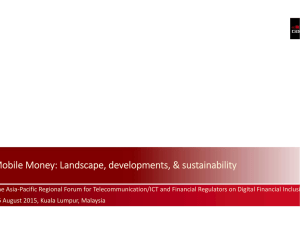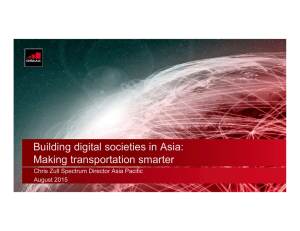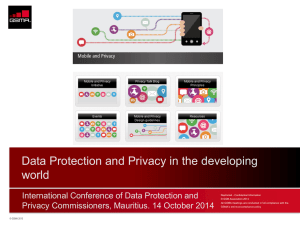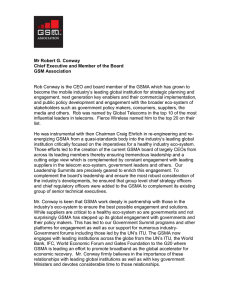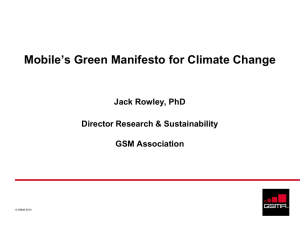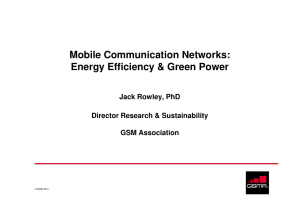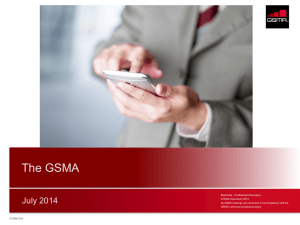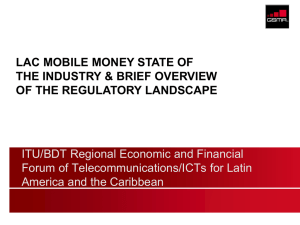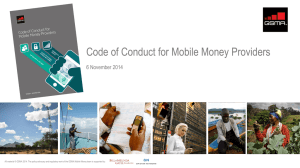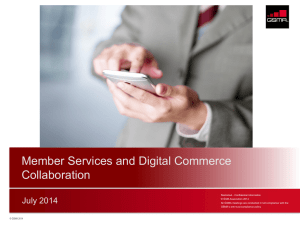Presentation
advertisement
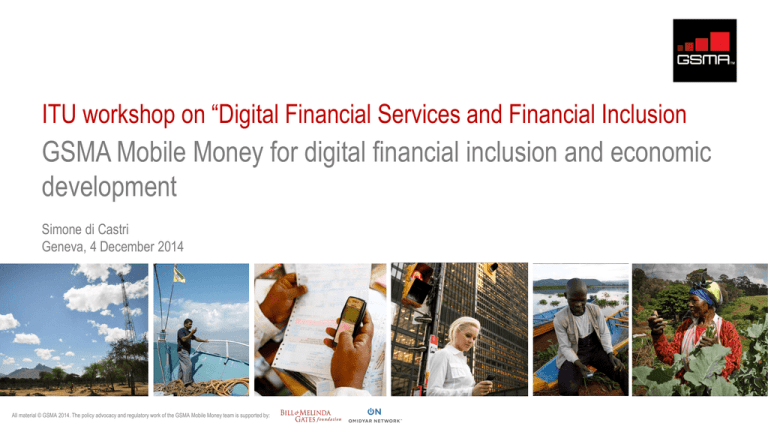
ITU workshop on “Digital Financial Services and Financial Inclusion GSMA Mobile Money for digital financial inclusion and economic development Simone di Castri Geneva, 4 December 2014 All material © GSMA 2014. The policy advocacy and regulatory work of the GSMA Mobile Money team is supported by: The GSMA unites nearly 800 of the world’s mobile operators from 219 countries, as well as more than 200 companies in the broader mobile ecosystem. The Mobile Money programme equips GSMA members to sustainably participate in the development of a sound and inclusive digital ecosystem scaling mobile money services and implementing partnerships with other providers. Achieve financial inclusion, enable innovation and build the digital economy leveraging mobile money MOBILE MONEY Both banks and non banks are allowed to provide mobile money services sustainably and a functional and proportional regulatory framework ECOSYSTEM Mobile money providers implement wallet to wallet interoperability and offer other financial services Other entities use mobile money platform to provide financial and non-financial (M4D) services Merchants, governments and business are financially connected through mobile money platforms 1.7b+ HAVE A MOBILE What we do PUBLIC POLICY OBJECTIVE Help providers and regulators to create and maintain policy environments that allow mobile the sustainable development of an inclusive digital ecosystem, providing a foundation for socio-economic development through mobile-based services PUBLIC POLICY ACTIVITIES Gather and analyse market data and commercial practices Build evidence-based body of knowledge on enabling policy solutions Create awareness among stakeholders (operators, policymakers, regulators, partners) Build effective dialogue and collaboration between stakeholders Advocate for reforms that support customer activation, the sustainable provision of mobile financial services and a scalable ecosystem INDUSTRY CAPACITY BUILDING Equip the industry to improve compliance and risk mitigation/management (Code of Conduct) Activities and outputs GLOBAL Engagement with standard setters: BIS, FATF, ITU, ISO Engagement with development partners: (WB, IFC, UNCDF, CGAP, AFI, etc.) Events: Leadership Forum Position papers & case studies COUNTRY LEVEL ENGAGEMENTS Work with regulators (BCEAO, Colombia, Liberia, etc.) Position papers (India, Rwanda) COMMUNICATION Online tools: Mobile Money Regulatory Guide, etc. CAPACITY BUILDING Trainings and toolkits for operators and regulators The GSMA Code of Conduct for Mobile Money Providers 1. Mobile money providers (“providers”) safeguard customer funds against risk of loss 2. Providers have in place effective, proportional risk-based mechanisms to prevent, detect, and report the misuse of services for the purpose of money laundering or terrorist financing (ML/TF) 3. Providers screen, train, and monitor staff, agents and entities providing outsourced services to ensure that they offer safe and reliable services and comply with all relevant operational and legal requirements 4. Providers have well-developed policies and processes and sufficient network and system capacity to ensure reliable service provision 5. Providers take robust steps to ensure the security of the mobile network and channel 6. Providers communicate clear, sufficient, and timely information in a manner that customers can understand so that customers can make informed decisions 7. Providers have in place mechanisms to ensure that complaints are effectively addressed and problems are resolved in a timely manner 8. Providers collect, process, and/or transmit personal data fairly and securely Number of transactions relative to addressable market Mobile money market analysis 0.5 0.45 0.4 0.35 MNO-operated services and MNO subsidiaries Bank-operated services Third parties provider Slow growing services 0.3 0.25 0.2 0.15 0.1 0.05 0 0 10 20 30 40 Months since launch 50 60 70 80 Regulatory frameworks and financial access 56 countries with live mobile money deployments (July 2013) 668,000,000 adults in 29 countries 2.6 billion adults 1,940,000,000 adults in 27 countries Enabling Regulation Enabling regulation: open and level playing field Non-banks, including MNOs, can provide the service Cash-in and cash-out at agents is allowed Non enabling regulation Only banks, MFIs, or third parties allowed (no MNOs) If MNOs allowed, CICO network not allowed Mobile money agents 40%Enabling Regulation 19% Non-enabling Regulation 62% ACTIVE 42% ACTIVE 458,724 AGENTS 427,688 AGENTS Non-enabling Regulation Considering the countries with live mobile money deployments at July 2013, the enabling regulations prove to have a great impact on the provider’s willingness and capacity to build a functional distribution network to increase financial access Regulatory frameworks and financial inclusion/integrity The importance of getting customers active at registration 668,000,000 adults in 29 countries 1,940,000,000 adults in 27 countries Considering the fast growing providers at July 2013, the enabling KYC requirements prove to have great impact on customer activation and on the provider’s capacity to build a sustainable business Key regulatory principles Mobile money can effectively contribute to financial It helps to reduce the vulnerability of the financial system and mitigate inclusion, stability, integrity, and consumer protection risks due to the widespread use of cash and informal financial services OPEN AND LEVEL PLAYING FIELD Regulations shall allow for a diversity of payment methods and broadness of scope for funds transfer and storage. To unleash the potential of mobile money, regulators must create an open and level playing field that allows both banks and non-bank providers to offer mobile money services – particularly MNOs, which are well suited to building sustainable services and extending the reach of the formal financial sector rapidly and soundly. DISTRIBUTION AND OUTSOURCING Regulations shall allow banks and non-banks to outsource customer registration, cash collection, and disbursement activities to third parties to lower the cost of financial services, expand their reach, and thereby increase financial inclusion. Building an efficient mobile money distribution network depends on proportional and cost-effective regulation. STORE OF VALUE AND SAFEGUARD OF CUSTOMER MONEY There exist a category of accounts, other than traditional deposit accounts, in which repayable funds can be held on behalf of the client for general purposes for a period beyond a short time frame. To safeguard funds entering the system, providers shall keep them in pooled ring-fenced accounts held in banks. This would mitigate the liquidity risks posed by licensed non-bank mobile money providers and allow them meet customer demand to cash out electronic value. Mobile money reduces the risk of money laundering and terrorist financing since electronic transactions can be monitored and traced more easily than cash. Proportional AML/CFT regimes and simplified riskbased customer due diligence (CDD) requirements are crucial for customer adoption of mobile money. Regulations shall allow agents to register customers and remote account opening levering SIM registration records. Following customer identification accounts shall be activated without delay. CONSUMER PROTECTION INTEROPERABILITY Mobile money strikes a balance between creating innovative forms of financial access and offering an acceptable level of consumer protection. Tailored guidance from the regulator can help mobile money providers to improve transparency in their relationships with customers and prevent third party fraud. CUSTOMER DUE DILIGENCE Service providers and policymakers should work together to understand different types of interoperability, including the benefits, costs, and risks. Policymaker shall enable market-led solutions, ensuring that they interoperability brings value to the customer, makes commercial sense, is set up at the right time, and regulatory risks are identified and mitigated. GSMA for interoperability MNOs lead the operations of 147 mobile money services (60% of all mobile money services globally), and the vast majority of the most successful deployments In April 2014 GSMA members gave mandate to the Mobile Money team to identify markets with potential and support implementation of wallet to wallet interoperability (select model, agree on rules, operationalize) We aim at implementing interoperability for the whole ecosystem growth (therefore not only between operators) GSMA criteria for identifying markets ready to move forward: – – – Population size 6million + MNOs willing to interoperate No major regulatory hurdles From 20 assessments GSMA members have committed in five markets: – Myanmar, Pakistan (live), Rwanda (approved), Tanzania (live), Undisclosed ITU Focus Group: some ideas for the agenda PRIORITIES Codification of digital finance terminology Financial reconciliation: how to reconcile e-money in mobile money accounts with the trust accounts Security: security of 3rd party connection, user accounts, etc. Monitoring/Alerting: integration patterns for the rest of the Telco IT domains including customer relationship management (CRM), business intelligence (BI), enterprise resource planning (ERP) as well as the usual network elements ADDITIONAL AREAS OF ATTENTION Privacy: Protection of customer data from improper use from public authorities Taxation v. development objectives Thank you
